Chapter III -1 :Quality of the Environment in Japan 1998
Chapter III: Transformation of Current Lifestyles
1. Reduction of environmental load derived from individuals' lives
In past years, the central focus of environmental issues was industrial pollution. The pattern was that the polluters were commercial enterprises, and the sufferers were residents in the immediate area that had been targeted by the companies' operations. In recent years, however, the main environmental issues are on a global scale and some have become related to problems deriving from urbanisation and our own daily lives. In this respect each of us is both cause and victim. Although it has been said that "we need to change our lifestyle," in reality, it is difficult to feel or appreciate the environmental load that is generated by our own individual activities. This chapter examines who should do what to effectively reduce pressures on the environment in our daily lives.
The maintenance of a rich exchange between nature and human beings is an important part of the long-term goal of "coexistence" as stipulated in the Basic Environment Plan. Bearing this fact in mind, this chapter will try to clarify what the desirable lifestyle actually is from the viewpoint of the environment.
Environmental load created by the lives of human beings
Environmental load relating to global warming
According to 1995 figures, CO2 emissions from households (meaning emissions generated by electricity and fuel use by households) accounted for approximately 20% of all CO2 emissions in Japan. CO2 emission by business activities and industry amounted to approximately 80%. A little more than 10% of household emissions were actually emitted from houses and slightly less than 10% were emitted from means of transportation such as the use of private cars.
An analysis of the growth rates of emissions between 1990 and 1995, reveals that household emissions had grown by approximately 20% whereas industrial emissions had risen by about 5%. This shows that growth in household emissions has been much higher than growth in business-related emissions.
Changes in Household CO2 Emission by Source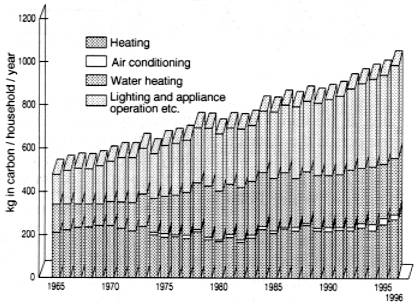
Source: Junkankyo Research Institute Inc.
Regarding changes in the sources of CO2 household emissions, water heating, lighting/power and air conditioning are all emission growth areas. Also, the life cycle energy of household electric appliances shows that energy used in the manufacturing process is much less than the energy consumed during the appliances actual use in the home. Therefore, the ways consumers use such appliances and their energy efficiency have an important influence on the amount of environmental load generated. In the transport sector, the energy required to carry one person the distance of 1km is the greatest for automobiles. Therefore, walking/bicycling, and the improvement and wider use of public transport are desirable.
Life Cycle Energy of Household Electric Appliances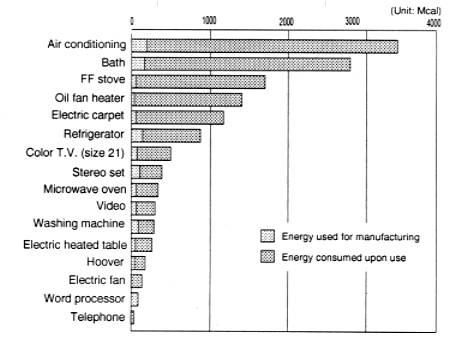
- Source:
- Compiled by the Environment Agency from "Life Cycle Energy in the Household" by the Japan Resources Association
Comparison of Energy Consumed
to Carry One Person for the Distance of 1 km (1995)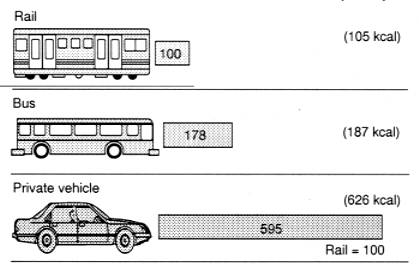
Source: Ministry of Transport
Status of Water Pollution and Utilisation of Water Resources
It has been found that household effluent is responsible for as much as 70% of the Chemical Oxygen Demand (COD) in the closed water of the Tokyo Bay. Moreover, the amount of household water use in 1994 was 3.5 times more compared with the figure for 1965.
Percentage of Pollutant Sources in the Tokyo Bay (COD, 1994)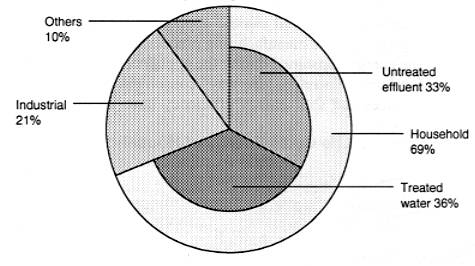
Source: Environment Agency
Waste
In the total weight of household waste, nearly 50% is kitchen waste and around a quarter is accounted for by paper products. Moreover, container and packaging waste accounts for more than a quarter of household waste by weight, and nearly 60% by volume. The increase/decrease of these types of waste are dependent more on the degree of effort made by producers and retailers rather than the efforts made by individuals at the household level.
Composition of Household Waste (Tokyo 23 wards and Kyoto City, 1996, by weight)
Tokyo 23 wards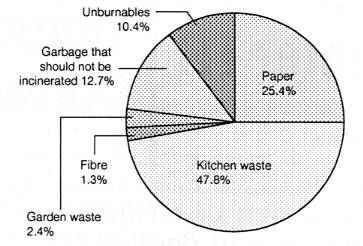
- Source:
- Compiled by the Environment Agency from the "Public Cleansing Services '97,"
by the Bureau of Public Cleansing of the Tokyo Metropolitan Government
Kyoto City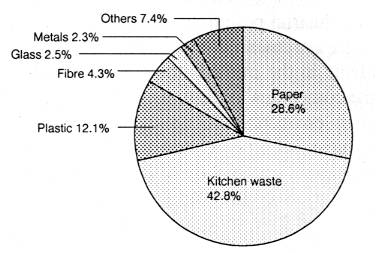
- Source:
- Compiled by the Environment Agency from the "Report on the Detailed Composition Survey of Household Waste" by the Bureau of Public Cleansing of the Kyoto City Government
Percentage of Containers and Packing Waste in Household Waste (1996)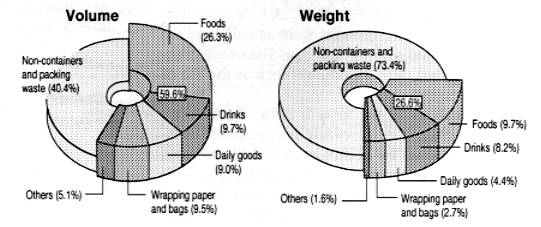
Source: Ministry of Health and Welfare
Roles of Each Party
Bearing in mind the above examples, reducing environmental load in individual lives is only possible, not just by means of individual actions but also by taking into account the whole economic and social system which is dependent on the actions of those different parties that make up society such as commercial enterprises, governments, and Non Governmental Organisations (NGOs).
For instance, commercial enterprises can reduce environmental load generated by the daily lives of individual citizens by (1) providing products or services with high energy efficiency, and recyclable products with low environmental load; and (2) reducing environmental load by choosing environmentally friendly manufacturing and transportation methods. Governments can change the degree of environmental load generated by individuals lives by (1) constructing environmentally friendly social services such as sewage systems and transport systems such as roads, which are panned and maintained by governments in conjunction with private companies.
Governments can also influence the amount of environmental load by (2) setting up various systems and rules to restrict the actions of commercial enterprises an citizens.
The suggestion "there is a need to change our lifestyle to one that is more environmentally caring" not only demands changes in the way individual citizens live their lives but also in the way business and public sectors operate. At the governmental level, in order to reduce pressure on the environment exerted by individual citizens lives, it is necessary to revise a wide range of policies and measures taking into account the environmental perspective.
Measures to Reduce Environmental Load in the Life of the Individual
Measures that can be taken by individual citizens
Our daily lives create environmental stress in all areas of activity, however a little bit of thought and effort can reduce pressure on the environment, thereby contributing to the solution of environmental problems.
Control of CO2 emission is one example. There are so many aspects of life at home that result in CO2 emission, for example the use of electricity, gas, kerosene, gasoline and water. According to the calculations compiled in 1997 by the Lifestyle Commission to Arrest Global Warming, it is possible for each household to reduce CO2 emission each year by about 1.2 tonnes. This is possible by combining measures such as using heating, air conditioning and gas appliances more efficiently, and by promoting energy and water saving, recycling and by reducing the use of automobiles. In 1995, annual CO2 emission per household amounted to around 3.6 tonnes in Japan, and the Lifestyle Commission's calculations suggest that reductions by as much as one third is possible.
Keeping an "household eco-account book" that records environmentally positive and negative actions and calculates the amount of environmental load generated, is a useful way to objectively evaluate one's own actions in order to establish a lifestyle that reduces pressure on the environment.
Measures that can be taken by the business sector
Roles of commercial enterprises
Companies have started making efforts by choosing environmentally friendly materials to reduce environmental load in the manufacturing and marketing process.
Because enterprises can provide goods with less environmental load and services that can reduce environmental stress, they have a major role to play in reducing environmental load created in the lives of individual citizens. It is also necessary to change the current social system to support commercial enterprises in taking actions that care for the environment.
Development of products with reduced environmental load such as low pollution vehicles is dependent on the technological capacity of commercial enterprises, and as it often leads to increasing the reputation of the enterprises themselves, more and more companies are making efforts to develop such products.
According to a survey conducted by the National Institute for Environmental Studies, 77.4% of consumers are hoping that "manufacturers should collect and dispose of waste products with a sense of responsibility," however, only 35.5% of manufacturers are aware of such consumer expectations.
Percentage of Companies Demanding Environmental Care on the Part of Other Companies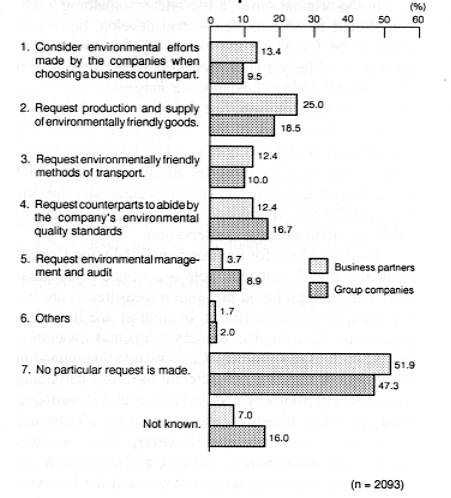
Source: Environment Agency
Moreover, nearly a half of companies targeted in this survey has made no request to business partners and companies in the same business group regarding environmental concerns. This shows that there needs to be an increased effort to demand environmentally friendly products when buying parts from suppliers or to choose companies with a good environmental record.
Furthermore, reducing environmental load in the manufacturing process is another important role commercial enterprises can play. It is necessary to reduce the use of toxic substances to reduce stresses on the environment at the disposal stage.
Many consumers also consider that environmental problems are something governments and commercial enterprises can solve, rather than perceiving environmental problems as their own problems. We must think about what we should do and then act in order to amplify and augment those actions being taken by the commercial sector to solve environmental problems.
In order to tackle environmental problems resulting from the daily activities of individuals, it is necessary for each of us to recognize that we are the causes of environmental stress. It is important to recognize environmental problems as our own. We can find a clue for their solution through cooperation between the three bodies, namely individual citizens, commercial enterprises and governments.
Measures that can be taken by government
Comprehensive measures to reduce environmental pressures generated by the lives of individuals
In the original sense, a lifestyle is something a citizen should be able to choose and develop, not something to be forced on the citizen by the government. However, a lifestyle is always influenced by the notion of "average" living standards - a judgement that is socially defined. Moreover, one can only choose a lifestyle within the framework of the existing legal system, and within the prevailing economic and social system. Therefore, since our daily lifestyles are inflicting significant pressures on the environment, it is necessary for the Government to give guidance and support to citizens to facilitate environmental conservation.
The Basic Law for Environmental Pollution Control stipulated that the citizens' role is confined to cooperation with such pollution prevention measures as are being taken by the Government. In contrast, the Basic Environment Plan emphasizes environmental awareness raising such as environmental information dissemination to citizens. It also lays out different measures pertaining to various environmental issues such as global warming, waste/recycling measures, and securing the coexistence of nature and human being s. However, these measures are still not systematized, and lack a clear relationship between each recommended measure and the lifestyles of citizens as a whole.
Approach to the activities of citizens and commercial enterprises
(Promotion of Environment Education and Learning)
International efforts have been made given the Declaration of the Human Environment adopted at the United Nations Conference on the Human Environment in 1972 and the Belgrade Charter regarding environmental education adopted in 1975 at the International Environmental Education Workshop. In Japan, based on the Basic Environment Law established in 1994 and the Basic Environment Plan adopted at the Cabinet meeting in the same year, the Government is comprehensively promoting environmental education and positive learning.
Environmental education and learning for children should aim to raise environmental awareness by arousing interest and understanding of the relationship between humans and the environment through experiencing nature and outdoor activities. The Environment Agency has urged elementary and junior high school students to join the Junior Eco-Club. In conjunction with local governments, the Club supports in order that children can enjoy environmental learning and activities in their region. As of 1997, about 3,500 clubs had been formed throughout Japan and around 55,000 students had participated in the programme.
In addition, it is important to give opportunities to all age groups to participate in environmental education and learning. The Environment Agency has organized "Eco-Life Workshops" at eight different venues, training personnel who can plan and manage such events. The Ministry of Education, Science, Sports and Culture is planning to increase opportunities for environmental learning at social education facilities such as museums and public halls. In the Lake Biwa Museum in Shiga Prefecture the plan has already been put into practice.

Rice planting jointly carried out by citizens and farmers
Photo: Network for Sustainable Rural Communities (NSRC)
Economic measures
Apart from costs paid by producers of goods and services, there is a hidden cost which is not transmitted through the existing market system and is borne, ultimately, by society as a whole. This is called "external cost" and a representative example is environmental load or environmental stress.
The application of economic measures, through the provision of incentives, makes it possible to effectively internalize such external costs through the market mechanism.
The deposit-refund system is an example of this kind of economic measure. This system aims to raise recovery rates of used products, by adding a deposit to an original price and by refunding the deposit to the consumer upon the return of the used product. The chart on the following page shows the flow of containers in the deposit system employed in the United States.
Flow of Containers Under the Deposit System in the New York State in U.S.A.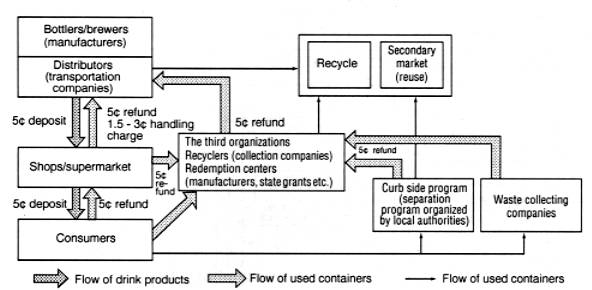
Source: Environment Agency
In recent years, in the OECD nations, the concept of "green tax reform" is attracting attention. By taxing activities that cause environmental load (BADS taxation) on one hand, and reducing tax on profits gained by economic activities that exert reduced pressures on the environment (GOODS tax reduction), it aims to promote effective environmental conservation and to secure both the efficient use of resources and higher productivity.
Reform of Government activities
In addition to working with individuals and commercial enterprises, it is necessary to make the government's work more environmentally friendly. Social services, for example, can be improved to reduce environmental load.
In Japan, as transport systems developed and people's spheres of movement became magnified, it became very convenient to shop in large suburban supermarkets. At the same time, many traditional shopping streets are losing vigor, and with the ageing population, these communities themselves are threatened with dissolution. It is also feared that sprawling cities might negatively affect the surrounding environment.
In order to create the society where the transport sector generates less CO2 emission, it is necessary to create compact areas. Public services and functions such as shops would be concentrated in areas which can be reached on foot, by bicycle or by using public transport.
Creating towns which reduce the use of private vehicles not only reduces CO2 emissions, but also prevents the unplanned sprawl of cities and the creation of vacuums in urban centers.
Changes in Means of Transportation for Commuting in Sapporo City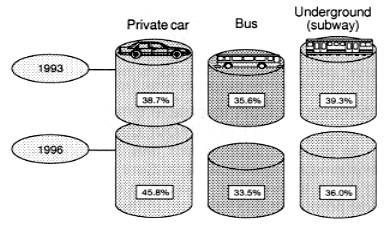
Source: Sapporo City
The strengths of the individual
The influence that individual citizens exert goes far beyond the simple cumulative effect of making small but effective efforts. As exemplified in citizens activities, the consumers movement and efforts to choose green products, a change in people's consciousness and actions can motivate, both directly and indirectly, other individuals, the private commercial sector and governments. Changes in individual consciousness, and changes of corporate activities and government policies can influence each other and make each change more substantial and effective. Through this process, changes in individual thinking and actions have the potential to coalesce into a major force for change, unthinkable given the small scale of initial movement. This force has the potential to change social systems and industrial structures, and to create an economy and society based on a new set of values.
Counter-eutrophication measures in the Lake Biwa area
In 1977, as red tides occurred, a growing movement to use powdered soap instead of synthetic detergent started in Shiga Prefecture. The Shiga prefectural government declared that the establishment of a new ordinance would be discussed on the precondition that citizens would voluntarily encourage use of powdered soup and raise the user ratio to over 50%. Citizens rose to the challenge meeting these terms and at the same time expressed support for environmental conservation by strengthening the movement that directly appealed to the government and companies. As a result, the ordinance to prevent eutrophication of Lake Biwa was established. The movement also encouraged companies to sell non-phosphorus synthetic detergent and to re-manufacture of powdered soap.
The milk carton collection movement
The movement to collect milk cartons began among certain groups of housewives. However, it grew to have a power to influence governments and corporations such as paper manufacturers and supermarkets. As a result, a new collection and recycling route was created to reutilize milk cartons that had previously been wasted after use. Finally, milk cartons were designated as a target item for waste separation legislation.
Individuals can have a great influence over commercial enterprises and governments by choosing commodities and becoming involved in direct consumer movements. Therefore, the positive involvement of individuals in the reduction of environmental load is expected. It is also necessary to act appropriately based on correct knowledge and information since the influence of action can be far-reaching.
Correlation of each party's actions in reducing environmental load in individual lives
The chart above shows how actions taken by three parties (individual citizens, commercial enterprises and governments) and other elements in society relate to each other, using an example of an effort to reduce CO2 emission from energy consumption at home as a countermeasure to global warming. In order to reduce environmental load resulting from the lives of individuals, measures must be taken by all the parties that go to make up our society. In addition, policy makers must be aware of the complex mutual relationship that exists between these parties and should promote the efforts made by each party, while at the same time formulating a set of systematic measures with full awareness of the factors involved.
Correlation of Measures Taken by Each Party for
the Reduction of CO2 Derived from Household Energy Use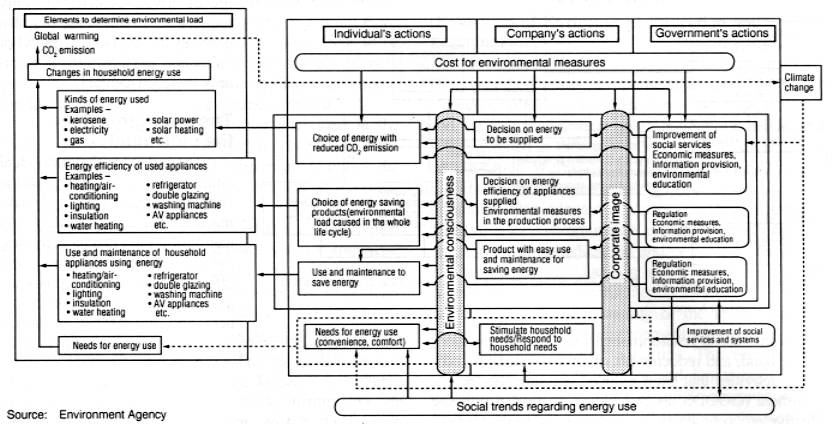
Source: Environment Agency